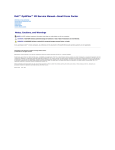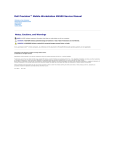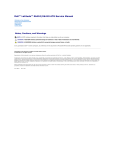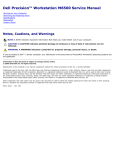Download Dell Latitude Z600 Specifications
Transcript
Dell™ Latitude™ Z600 Service Manual Working on Your Computer Adding and Replacing Parts Specifications Diagnostics Passwords System Setup Notes, Cautions, and Warnings NOTE: A NOTE indicates important information that helps you make better use of your computer. CAUTION: A CAUTION indicates potential damage to hardware or loss of data if instructions are not followed. WARNING: A WARNING indicates a potential for property damage, personal injury, or death. If you purchased a Dell™ n Series computer, any references in this document to Microsoft® Windows® operating systems are not applicable. Information in this document is subject to change without notice. © 2009 Dell Inc. All rights reserved. Reproduction of this material in any manner whatsoever without the written permission of Dell Inc. is strictly forbidden. Trademarks used in this text: Dell, the DELL logo, Latitude, TravelLite, Wi-Fi Catcher, and ExpressCharge, are trademarks of Dell Inc.; Intel, Pentium, Celeron, Intel Atom, and Core are either trademarks or registered trademarks of Intel Corporation; Bluetooth is a registered trademark owned by Bluetooth SIG, Inc. and is used by Dell under license; TouchStrip is a trademark of Zvetco Biometrics, LLC; Blu-ray Disc is a trademark of the Blu-ray Disc Association; Microsoft, Windows, Windows Server, MS-DOS, Aero, Windows Vista, and the Windows Vista start button are either trademarks or registered trademarks of Microsoft Corporation in the United States and/or other countries; Adobe, the Adobe logo, and Adobe Flash Player are trademarks of Adobe Systems Incorporated. Other trademarks and trade names may be used in this document to refer to either the entities claiming the marks and names or their products. Dell Inc. disclaims any proprietary interest in trademarks and trade names other than its own. September 2009 Rev. A00 Back to Contents Page System Setup Dell™ Latitude™ E5400 Discrete Service Manual Entering System Setup Boot Menu Navigation Keystrokes System Setup Menu Options Your computer offers the following BIOS and System Setup options: l l l Access System Setup by pressing <F2> Bring up a one-time boot menu by pressing <F12> Access the Intel® AMT settings by pressing <Ctrl> + <P> Entering System Setup Press <F2> to enter System Setup and make changes to user-definable settings. If you have trouble entering System Setup using this key, press <F2> when the keyboard lights first flash. Boot Menu Press <F12> when the Dell™ logo appears to initiate a one-time boot menu with a list of the valid boot devices for the computer. Diagnostics and Enter Setup options are also included in this menu. The devices listed on the boot menu depend on the bootable devices installed in the computer. This menu is useful when you are attempting to boot to a particular device or to bring up the diagnostics for the computer. Using the boot menu does not make any changes to the boot order stored in the BIOS. Navigation Keystrokes Use the following keystrokes to navigate the System Setup screens. Navigation Keystrokes Action Keystroke Expand and collapse field <Enter>, left- or right-arrow key, or +/– Expand or collapse all fields <> Exit BIOS <Esc>—Remain in Setup, Save/Exit, Discard/Exit Change a setting Left or right-arrow key Select field to change <Enter> Cancel modification <Esc> Reset defaults <Alt><F> or Load Defaults menu option System Setup Menu Options The following tables describe the menu options for the System Setup program. General Option Description This section lists the primary hardware features of your computer. There are no configurable options in this section, only information. l l l System Information l System Information ¡ BIOS Version ¡ Service Tag ¡ Asset Tag ¡ Ownership Tag Memory Information ¡ Memory Installed ¡ Memory Available ¡ Memory Speed ¡ Memory Channel Mode ¡ Memory Technology ¡ DIMM A Size ¡ DIMM B Size Processor Information ¡ Processor Type ¡ Core Count ¡ Processor ID ¡ Current Clock Speed ¡ Minimum Clock Speed ¡ Maximum Clock Speed Device Information ¡ Primary Hard Drive ¡ Secondary Hard Drive ¡ System eSATA Device ¡ Video Controller ¡ Video BIOS Version ¡ ¡ ¡ ¡ ¡ ¡ ¡ ¡ Battery Information Video Memory Panel Type Native Resolution Audio Controller Wi-Fi Device Cellular Device Bluetooth Device Wireless USB Device Indicates the primary battery and the media bay battery status. Also displays the type of AC adapter connected to the computer. The computer attempts to boot from the sequence of devices specified in this list: l l l Boot Sequence l l l Diskette drive USB Storage Device CD/DVD/CD-RW Drive. Internal HDD (IRRT) (Secondary HDD name) Onboard NIC This list specifies the order that the BIOS searches devices when trying to find an operating system to boot. To change the boot order, select the device to be changed in the list then click the up/down arrows or use the keyboard PgUp/PgDn keys to change the boot order of the device. The boot devices can also be de-selected from the list using the check boxes. Date/Time Displays current date and time settings. System Configuration Option Description The System Configuration group contains options an settings relater to integrated system devices. (Depending on your computer and installed devices, the items listed in this section may or may not appear.) NOTE: This option configures the operating mode of the internal SATA hard drive controller. The settings are Disabled, ATA, AHCI, and IRRT. SATA Operation Default setting: IRRT Use the check boxes to enable/disable the following devices: Miscellaneous Devices l l l eSATA Ports External USB Port Microphone Default setting: All enabled. Use the check boxes to enable/disable the following devices: Enable Latitude ON = Latitude ON is available by pressing the Latitude ON button. Latitude ON Use instant on mode = Latitude ON will be instantly available by pressing the Latitude ON button when the computer is off or hibernated. Instant on mode will use a small amount of battery power to ensure availability of Latitude ON. Without Instant on mode, Latitude ON will take up to a minute longer to boot, but will not use any battery power when off. Keyboard Illumination This field lets you choose the operating mode of the keyboard illumination feature. The settings are Disabled, Auto ALS and Input, and Auto Input Only. Default setting: Auto ALS and Input USB PowerShare USB PowerShare Mode This option configures the USB PowerShare feature behavior. Use the check box to enable / disable the feature (default state is disabled). The settings are 0%, 3%, 10%, 25%, 50%, and 75%. Select either Mode A or Mode B. Uses Mode A by default. If your device fails to charge with Mode A, please try Mode B. Video Option Ambient Light Sensor Description Enabling ALS will allow your system to automatically change the brightness of your system's LCD panel based on the amount of light in the environment. Default setting: Disabled LCD Brightness This option (represented by a slider bar for On Battery and On AC) sets the panel brightness when the ambient light sensor is off. Security Option Description This field lets you set, change, or delete the administrator (admin) password (sometimes called the "setup" password). The admin password enables several security features when set including: l l l Admin Password l Restricts changes to the settings in Setup Restricts the boot devices listed in the <F12> Boot Menu to those enabled in the "Boot Sequence" field. Prohibits changes to the owner and asset tags. Substitutes for the system password if the system prompts for a password during power on. Successful changes to this password take effect immediately. NOTE: If you delete the admin password, the system password is also deleted. Also, the admin password can be used to delete the HDD password. For this reason, you cannot set an admin password if a system password or HDD is already set. The admin password must be set first if used in conjunction with a system and/or HDD password. System Password This field lets you set, change, or delete the system password (previously called the "Primary" password). This field lets you set, change, or delete the password on the system's internal hard disk drive (HDD). Successful changes take place Internal HDD PW immediately and require a system restart. The HDD password travels with the hard drive, so the HDD is protected even when installed in another system. This field lets you set, change, or delete the password on the system's second internal hard disk drive (HDD). Successful changes take place immediately and require a system restart. The HDD password travels with the hard drive, so the HDD is protected even when installed in another system. Secondary HDD PW Password Bypass This option lets you bypass the system and internal HDD password prompts during a system restart or when resuming from a standby state. Settings are Disabled, Reboot Bypass, Resume Bypass, and Reboot & Resume Bypass. The system will always prompt for the set system and internal HDD password when powered on from an off state (cold boot). Password Change This option lets you determine whether changes to the System and HDD passwords are permitted when an Admin password is set. Use the check box to allow or disallow changes. This option lets you control whether the Trusted Platform Module (TPM) in the system is enabled and visible to the operating system. When disabled (check box is empty), the BIOS will not turn on the TPM during POST. The TPM will be non-functional and invisible to the operating system. When enabled (check box filled) the BIOS will turn the TPM on during POST so the it can be used by the operating system. NOTE: Disabling this option does not change any settings you may have made to the TPM, nor does it delete or change any information or keys you may have stored there. It simply turns off the TPM so that it cannot be used. When you re-enable the TPM, it will function exactly as it did before it was disabled. TPM Security Once TPM is enabled (check box filled), the available settings are: Deactivate, Activate, and Clear. With the TPM in Deactivate mode it will not execute any commands that use the resources of the TPM, nor will it allow any access to stored owner information. The Clear setting allows the owner information stored in the TPM to be cleared. Use this to restore the TPM to its default state if you lose or forget the owner authentication data. This field lets you activate or disable the BIOS module interface of the optional Computrace software. The settings are Deactivate, Disable, and Activate. Computrace® The Activate and Disable options will permanently activate or disable the feature and no further changes will be allowed. This field enables or disables the Execute Disable mode of the processor. Use the check box to enable / disable this feature. CPU XD Support Default setting: Enabled This option lets you determine whether changes to the setup option are permitted when an administrator password is set. If disabled Non-Admin Setup the setup option is locked by the admin password. It cannot be modified unless setup is unlocked. Use the check boxes to allow / deny Changes access to the Wi-Fi Catcher Changes and / or Wireless Switch Changes within the system setup. Performance Option Description Multi Core Support Use the check box to enable / disable multi core support for the CPU. Intel® SpeedStep Use the check box to enable / disable mode for the CPU. Power Management Option Wake on AC Auto On Time Description Use the check box to enable / disable the computer to power up from the off or hibernation state when an AC adapter is inserted. This field sets the of days, if any, when you would like the system to turn on automatically. The settings are Disabled, Everyday, or Weekdays. Default setting: Off Use the check box to enable / disable the ability for USB devices to wake the system from Standby. USB Wake Support This feature is only functional when the AC power adapter is connected. If the AC power adapter is removed during Standby, the BIOS will remove power from all of the USB ports to conserve battery power. This field allows the computer to power up from the off state when triggered by a special LAN signal or from Hibernate state when triggered by a special wireless LAN signal. Wake-up from the Standby state is unaffected by this setting and must be enabled in the operating system. Wake on LAN/WLAN l l l l Disabled — Do not allow the system to power on when it receives a wake-up signal from the LAN or wireless LAN. LAN Only — Allow the system to be powered on by special LAN signals. WLAN Only — Allow the system to be powered on by special WLAN signals. LAN or WLAN — Allow the system to be powered on by special LAN or wireless LAN signals. The factory default setting is Off. Charger Behavior This field lets you enable / disable the battery charger. If disabled, the battery will not lose power when the system is connected to an AC adapter but it will not charge either. Default setting: Charger Enabled Wireless Adapter Enables / Disables the Wireless Adapter (charging coil for use with the wireless charging station) in the system. POST Behavior Option Adapter Warnings Description Use the check box to enable/disable the BIOS warning messages when you use certain power adapters. The BIOS displays these messages if you attempt to use a power adapter that has too little capacity for your configuration. The factory default setting is Enabled. This option lets you choose one of two methods to enable the keypad that is embedded in the internal keyboard. l l Keypad (Embedded) Fn Key Only — The keypad is only enabled when you hold down the <Fn> key. By Num Lk — The keypad is enabled when (1) the Num Lock LED is on and (2) no external keyboard is attached. Note that the system might not notice immediately when an external keyboard is detached. When Setup is running, this field has no effect—Setup works in the Fn Key Only mode. The factory default setting is Fn Key Only. Use the check box to enable/disable the Num Lock LED when the system boots. Numlock LED The factory default setting is Enabled. This option defines how the BIOS, in the absence of a USB-aware operating system, handles USB devices. USB emulation is always enabled during POST. Use the check box to enable / disable this feature. USB Emulation The factory default setting is Enabled. This field lets you use the <Scroll Lock> key on an external PS/2 keyboard the same way you use the <Fn> key on the computer's internal keyboard. Use the check box to enable / disable this feature. Fn Key Emulation USB keyboards cannot emulate the <Fn> key if you are running an ACPI operating system such as Microsoft® Windows® XP. USB keyboards will only emulate the <Fn> key in non-ACPI mode (e.g., when you are running a DOS). The factory default setting is Enabled. This field can speed up the boot process by bypassing some compatibility steps. l Fast Boot l l Minimal — Boot quickly unless the BIOS has been updated, memory changed, or the previous POST did not complete. Thorough — Do not skip any steps in the boot process. Auto — Allow the operating system to control this setting (this works only when the operating system supports Simple Boot Flag). The factory default setting is Minimal. Intel Fast Call for Used in conjunction with iAMT 4.0. Allows users to initiate contact with a management console while residing outside of the corporate Help infrastructure (i.e. remote location, behind a firewall or NAT, etc.) Use the check box to enable / disable this feature. Virtualization Support Option Description This field specifies whether a Virtual Machine Monitor (VMM) can utilize the additional hardware capabilities provided by Intel® Virtualization Technology. Use the check box to enable/disable this feature. Virtualization The factory default setting is Disabled. This option specifies whether a Virtual Machine Monitor (VMM) can utilize the additional hardware capabilities provided by Intel Virtualization Technology for Direct I/O. Use the check box to enable/disable this feature. VT for Direct I/O The factory default setting is Disabled. This option specifies whether a Measured Virtual Machine Monitor (MVMM) can utilize the additional hardware capabilities provided by Intel Trusted Execution Technology. The TPM, Virtualization Technology, and Virtualization Technology for Direct I/O must be enabled to use this feature. Use the check box to enable/disable this feature. Trusted Execution The factory default setting is Disabled. Wireless Option Description Wireless Switch Wireless Devices Use the check boxes to determine which wireless devices will be controlled by the wireless switch. The available options are WWAN, WLAN, and Bluetooth®. Use the check boxes to enable/disable the various wireless devices. The available options are Internal WWAN, Internal WLAN, and Internal Bluetooth. Maintenance Option Service Tag Asset Tag Description This field displays your system's Service Tag. If for some reason the Service Tag was not already set, you would be able to use this field to set it. If a Service Tag has not been set for this system, the computer will automatically bring up this screen when users enter the BIOS. You will be prompted to enter the Service Tag. This field allows you to create a system Asset Tag. The field can only be updated if the Asset Tag is not already set. System Logs Option Description BIOS Events This field allows you to view and clear BIOS POST events. It includes the date and time of the event as well as the LED code. DellDiag Events This field allows you to view the diagnostic results from DellDiags and PSA. It includes the time and date, the diagnostic and version which was run and the resulting code. Thermal Events This field allows you to view and clear thermal events. It includes the date and time as well as the name of the event. Power Events This field allows you to view and clear power events. It includes the date and time of the event as well as the power state and reason. Back to Contents Page Back to Contents Page Diagnostics Dell™ Latitude™ Z600 Service Manual Device Status Lights Battery Status Lights Battery Charge and Health Status No-POST Light Codes Device Status Lights Device status LEDs are a strong source for diagnosing common problems that occur on portable systems. The LED locations vary from system to system so be sure to review the specific training pages (typically found under the Chassis section) to learn where the LEDs are located. One thing that remains common on portable platforms is what each LED represents and how errors are displayed. Turns on when you turn on the computer and blinks when the computer is in a power management mode. Turns on when the computer reads or writes data. Turns on steadily or blinks to indicate battery charge status. Turns on when wireless networking is enabled. Turns on when a card with Bluetooth® wireless technology is enabled. To turn off only the Bluetooth wireless technology function, right-click the icon in the system tray and select Disable Bluetooth Radio. Battery Status Lights If the computer is connected to an electrical outlet, the battery light operates as follows: l l l l l Alternately blinking amber light and blue light — An unauthenticated or unsupported, non-Dell AC adapter is attached to your laptop. Alternately blinking amber light with steady blue light — Temporary battery failure with AC adapter present. Constantly blinking amber light — Fatal battery failure with AC adapter present. Light off — Battery in full charge mode with AC adapter present. Blue light on — Battery in charge mode with AC adapter present. Battery Charge and Health Status To check the battery charge, press and release the status button on the battery charge gauge to illuminate the charge-level lights. Each light represents approximately 20 percent of the total battery charge. For example, if four lights are on, the battery has 80 percent of its charge remaining. If no lights appear, the battery has no charge. To check the battery health using the charge gauge, press and hold the status button on the battery charge gauge for at least 3 seconds. If no lights appear, the battery is in good condition and more than 80 percent of its original charge capacity remains. Each light represents incremental degradation. If five lights appear, less than 60 percent of the charge capacity remains, and you should consider replacing the battery. No-POST Light Codes The numeric key light, caps lock light, and scroll lock light are also used to diagnose issues that may occur in a no-POST scenario. Appearance Description ON-FLASH-FLASH Next Step 1. 2. 4. Install supported memory modules. If memory is already present, reseat the module(s) one at time in each slot. Try known good memory from another computer or replace the memory. Replace the system board. System board error 1. 2. 3. Reseat the processor. Replace the system board. Replace the processor. LCD Panel Error 1. 2. 3. Reseat the LCD cable. Replace the LCD panel. Replace the video card/system board. 1. Install compatible memory modules. No SODIMMs are installed 3. FLASH-ON-ON FLASH-ON-FLASH OFF-FLASH-OFF 2. Memory compatibility error 3. 4. ON-FLASH-ON 1. 2. Memory is detected but has errors If two modules are installed, remove one and test. Try the other module in the same slot and test. Test the other slot with both modules. Replace the memory. Replace the system board. 3. 4. Reseat the memory. If two modules are installed remove one and test. Try the other module in the same slot and test. Test the other slot with both modules. Replace the memory Replace the system board. 1. 2. 3. Reseat the modem. Replace the modem. Replace the system board. 1. Replace the system board. 1. 2. 3. Reseat the device. Replace the device. Replace the system board. 1. 2. 3. 4. Reseat the hard drive and optical drive. Test the computer with just the hard drive and just the optical drive. Replace the device that is causing the failure. Replace the system board. 1. Replace the system board. OFF-FLASH-FLASH Modem Error FLASH-FLASH-FLASH System board error FLASH-FLASH-OFF Option ROM Error OFF-ON-OFF Storage device error FLASH-FLASH-ON Video card error Back to Contents Page Back to Contents Page Adding and Replacing Parts Dell™ Latitude™ Z600 Service Manual Battery Hinge Covers Access Panel Hard Drive Internal Card With Bluetooth® Wireless Technology Coin-Cell Battery Speakers WLAN Card WWAN Card Network Connector Power Connector System Board Display Assembly Ultra Wide Band (UWB) Card Heat Sink Assembly Wide Area Network (WLAN) Card Connector Charging Coil Keyboard and Palm-Rest Assembly Back to Contents Page Back to Contents Page Specifications Dell™ Latitude™ Z600 Service Manual Processor System Information Memory Ports and Connectors Communications Video Audio Display Keyboard Touch Pad Battery AC Adapter Fingerprint Reader Environmental Physical NOTE: Offerings may vary by region. For more information regarding the configuration of your computer, click Start (or Start in Windows® XP)® Help and Support, and then select the option to view information about your computer. Processor Processor type Intel® Core™ 2 Duo processor Ultra Low Voltage Front side bus frequency 800 MHz L2 cache 3 MB System Information System chipset Mobile Intel GS45 Express Chipset Data bus width 64 bits DRAM bus width dual-channel (2) 64-bit Processor address bus width 36 bits PCI bus 32 bits Memory Memory module connector Memory soldered to the system board Memory module capacities 2 GB and 4 GB fixed configurations Memory type DDR3 SODIMM Minimum memory 2 GB Maximum memory 4 GB Ports and Connectors Audio Stereo headphones and speakers connector Mini-Card One dedicated half mini-card slot for WLAN One dedicated full mini-card slot for WWAN/GPS (mobile broadband) Network Adapter RJ-45 connector USB Two 4-pin 2.0-compliant connectors NOTE: One USB connector can be used as an eSATA connector. The other USB connector with PowerShare can be used to charge a USB device when the computer is turned on or off. Video DisplayPort connector with legacy adapters Communications Network adapter 10/100/1000 Ethernet LAN on system board Wireless Internal WLAN, WWAN, Bluetooth®, and UWB wireless support (if optional cards are purchased) Video Type integrated on the system board Data bus integrated video Video controller Intel Graphics Media Accelerator Video memory up to 256 MB of shared memory Audio Audio type Two-channel high-definition audio codec Audio controller IDT 92HD81B Stereo conversion 24-bit (stereo digital-to-analog) 24-bit (stereo analog-to-digital) Interfaces: Internal High definition audio External Stereo headphones/speakers mini-connector Speakers One 4-ohm speaker Internal speaker amplifier 2-Watt channel into 4 ohms Volume controls Volume control buttons and program menus Display Type (active-matrix TFT) HD+ Active X/Y 198.45 mm (7.81 in) x 352.8 mm (13.9 in) Dimensions: Height 214 mm (8.43 in) Width 365 mm (12.37 in) Diagonal 406.4 mm (16 in) Maximum Resolutions 1600 x 900 at 262 K colors Operating angle 0° (closed) to 140° Refresh rate 60 Hz Viewing angle (horizontal) 55° Pixel pitch 0.2588 Power consumption (panel with backlight) 7.0 W (max) Keyboard Number of keys 83 (United States and China); 84 (Europe) Layout QWERTY/AZERTY Touch Pad X/Y position resolution (graphics table mode) 240 CPI Size: Width 91.0 mm (3.6-inch) sensor-active area Height 46.7 mm (1.8-inch) rectangle Battery Type "smart" lithium ion 4-cell: 40 Whr 8-cell: 80 Whr Dimensions: 4-cell battery Depth 36.11 mm Height 20.10 mm Weight 250.6 g 8-cell battery Depth 57.31 mm Height 21.00 mm Weight 475.7 g Voltage 4-cell lithium-ion battery 14.8 VDC 8-cell lithium-ion battery 14.8 VDC Temperature range Operating 0° to 35° C (32° to 95° F) Storage -40° to 60° C (-40° to 145° F) Coin-cell battery CR-2032 AC Adapter Input voltage 100–240 VAC Input current (maximum) 1.5 A Input frequency 50–60 Hz Output current 2.31 A Output power 45 W Rated output voltage 19.5 VDC Dimensions 16 x 50 x 90 mm Temperature range Operating 0° to 40° C (32° to 104° F) Storage –40° to 70° C (–40° to 158° F) Fingerprint Reader (optional) Type UPEK TCS3 TouchStrip™ strip sensor with CMOS active capacitive pixel-sensing technology Physical Height 4-cell 20.10 8-cell 21.00 mm Width Height 14.55—20.1 mm (0.57—.79 inches) Width 396.34 mm (15.6 inches) Depth 272.25 mm (10.72 inches) Weight 2 kg (4.5 lb) Environmental Temperature range Operating 0° to 35°C (32° to 95°F) Storage –40° to 65°C (–40° to 149°F) Relative humidity (maximum) Operating 10% to 90% (non-condensing) Storage 5% to 95% (non-condensing) Maximum vibration (using a random-vibration spectrum that simulates user environment) Operating 0.66 GRMS Storage 1.3 GRMS Altitude (maximum) Operating -5.2–3048 m Storage -15.2–10,668 m Airborne contaminant level G2 or lower as defined by ISA-S71.04-1985 Back to Contents Page Back to Contents Page Battery Dell™ Latitude™ Z600 Service Manual WARNING: Before working inside your computer, read the safety information that shipped with your computer. For additional safety best practices information, see the Regulatory Compliance Homepage at www.dell.com/regulatory_compliance. Removing the Battery NOTE: You may need to install Adobe Flash Player from Adobe.com in order to view the illustrations below. 1. 2. Follow the procedures in Before Working Inside Your Computer. Slide the battery release latch into the unlocked position. 3. Remove the battery from the computer. Replacing the Battery To replace the battery, perform the above steps in reverse order. Back to Contents Page Back to Contents Page Hinge Covers Dell™ Latitude™ Z600 Service Manual WARNING: Before working inside your computer, read the safety information that shipped with your computer. For additional safety best practices information, see the Regulatory Compliance Homepage at www.dell.com/regulatory_compliance. Removing the Hinge Covers NOTE: You may need to install Adobe Flash Player from Adobe.com in order to view the illustrations below. 1. 2. 3. Follow the procedures in Before Working Inside Your Computer. Remove the battery from the computer. Remove the screw that secures the right hinge cover to the computer. 3. Remove the right hinge cover from the computer. 4. Repeat the procedure to remove the left hinge cover. Replacing the Hinge Covers To replace the hinge covers, perform the above steps in reverse order. Back to Contents Page Back to Contents Page Keyboard and Palm-Rest Assembly Dell™ Latitude™ Z600 Service Manual WARNING: Before working inside your computer, read the safety information that shipped with your computer. For additional safety best practices information, see the Regulatory Compliance Homepage at www.dell.com/regulatory_compliance. Removing the Keyboard and Palm-Rest Assembly NOTE: The keyboard and palm-rest assembly is a one-piece assembly which serves as your computer's main structure. Your computer was designed to have all parts mount to the keyboard and palm-rest assembly. 1. 2. 3. 4. 5. 6. 7. 8. 9. Follow the procedures in Before Working Inside Your Computer. Remove the battery from the computer. Remove the access panel from the computer. Remove the WLAN card from the computer. Remove the WWAN card from the computer. Remove the display assembly from the computer. Remove the hard drives from the computer. Remove the charging coil from the computer if applicable. Remove the system board from the computer. CAUTION: The keyboard and palm-rest assembly service kit ships with three foam rings that provide additional support for the internal chassis. Failure to install the foam rings may result in damage to your computer. 10. Examine the foam ring configuration on the old keyboard and palm-rest assembly, and then, using the foam rings included in the keyboard and palmrest assembly kit, affix the new foam rings in the same pattern on the new assembly. Replacing the Keyboard and Palm-Rest Assembly To replace the keyboard and palm-rest assembly, perform the above steps in reverse order. Back to Contents Page Back to Contents Page Access Panel Dell™ Latitude™ Z600 Service Manual WARNING: Before working inside your computer, read the safety information that shipped with your computer. For additional safety best practices information, see the Regulatory Compliance Homepage at www.dell.com/regulatory_compliance. Removing the Access Panel NOTE: You may need to install Adobe Flash Player from Adobe.com in order to view the illustrations below. 1. 2. 3. 4. Follow the procedures in Before Working Inside Your Computer. Remove the battery from the computer. Remove the hinge covers from the computer. Loosen the captive screws that secure the small access door to the computer. 5. Remove the access door from the computer. 6. Remove the screws inside the access door bay. 7. 8. Remove the SIM card if applicable. Remove the screws that secure the access panel to the computer in the battery well. 9. Remove the screw on the inside of the right hinge assembly. 10. Remove the screws that secure the access panel to the computer. 11. Remove the access panel from the computer. Back to Contents Page Back to Contents Page Hard Drive Dell™ Latitude™ Z600 Service Manual WARNING: Before working inside your computer, read the safety information that shipped with your computer. For additional safety best practices information, see the Regulatory Compliance Homepage at www.dell.com/regulatory_compliance. NOTE: You may need to install Adobe Flash Player from Adobe.com in order to view the illustrations below. Removing the Primary Hard Drive Replacing the Primary Hard Drive Removing the Secondary Hard Drive Replacing the Secondary Hard Drive Removing the Primary Hard Drive 1. 2. 3. 4. Follow the procedures in Before Working Inside Your Computer. Remove the battery from the computer. Remove the hinge covers from the computer. Remove the access panel from the computer. 5. Disconnect the hard-drive cable from the connector on the system board. 6. Remove the screws that secure the primary hard drive to the computer. 7. Lift the primary hard drive from the computer. Replacing the Primary Hard Drive To replace the primary hard drive, perform the above steps in reverse order. Removing the Secondary Hard Drive NOTE: You may need to install Adobe Flash Player from Adobe.com in order to view the illustrations below. 1. 2. 3. 4. 5. Follow the procedures in Before Working Inside Your Computer. Remove the battery from the computer. Remove the hinge covers from the computer. Remove the access panel from the computer. Release the Bluetooth® module cable from its connector by drawing the two gray tabs outward and away from the white connector. 6. Disconnect the Bluetooth module cable from its connector on the system board by pulling it slowly from the connector. 7. Release the bio-metric reader cable from its connector by drawing the two gray tabs outward and away from the white connector. 8. Disconnect the bio-metric reader cable from its connector on the system board by pulling it slowly from the connector. 9. Disconnect the secondary hard drive cable from the secondary hard drive. 10. Remove the screws that secure the hard drive to the computer. 11. Sliding the secondary hard drive from under the ribbon cables, remove the secondary hard drive from the computer. Replacing the Secondary Hard Drive To replace the secondary hard drive, perform the above steps in reverse order. Back to Contents Page Back to Contents Page Internal Card With Bluetooth® Wireless Technology Dell™ Latitude™ Z600 Service Manual WARNING: Before working inside your computer, read the safety information that shipped with your computer. For additional safety best practices information, see the Regulatory Compliance Homepage at www.dell.com/regulatory_compliance. Removing the Bluetooth Module NOTE: You may need to install Adobe Flash Player from Adobe.com in order to view the illustrations below. 1. 2. 3. 4. 5. Follow the procedures in Before Working Inside Your Computer. Remove the battery from the computer. Remove the hinge covers from the computer. Remove the access panel from the computer. Disconnect the Bluetooth module cable from the system board. 6. Remove the screw that secures the Bluetooth module to the computer. 7. Remove the Bluetooth module from the computer. Replacing the Bluetooth Module To replace the Bluetooth module, perform the above steps in reverse order. Back to Contents Page Back to Contents Page Coin-Cell Battery Dell™ Latitude™ Z600 Service Manual WARNING: Before working inside your computer, read the safety information that shipped with your computer. For additional safety best practices information, see the Regulatory Compliance Homepage at www.dell.com/regulatory_compliance. Removing the Coin-Cell Battery NOTE: You may need to install Adobe Flash Player from Adobe.com in order to view the illustrations below. 1. 2. 3. 4. 5. Follow the procedures in Before Working Inside Your Computer. Remove the battery from the computer. Remove the hinge covers from the computer. Remove the access panel from the computer. Disconnect the speaker cable from its connector on the system board. 6. Disconnect the coin-cell battery cable from its connector on the system board. 7. Remove the coin-cell battery from under the flat copper cable assembly, then lift the battery from the computer. Replacing the Coin-Cell Battery To replace the coin-cell battery, perform the above steps in reverse order. Back to Contents Page Back to Contents Page Speakers Dell™ Latitude™ Z600 Service Manual WARNING: Before working inside your computer, read the safety information that shipped with your computer. For additional safety best practices information, see the Regulatory Compliance Homepage at www.dell.com/regulatory_compliance. Removing the Speakers NOTE: You may need to install Adobe Flash Player from Adobe.com in order to view the illustrations below. 1. 2. 3. 4. 5. Follow the procedures in Before Working Inside Your Computer. Remove the battery from the computer. Remove the hinge covers from the computer. Remove the access panel from the computer. Disconnect the speaker cable from the system board. 6. Remove the screws that secure the right speaker. 7. Lift the speaker from the computer and lay it next to the computer. 8. Remove the screws that secure the left speaker. 9. Lift the speaker from the computer and lay it next to the computer. 10. Remove the speaker assembly from the computer. Replacing the Speakers To replace the speakers, perform the above steps in reverse order. Back to Contents Page Back to Contents Page Wireless Large Area Network (WLAN) Card Dell™ Latitude™ Z600 Service Manual WARNING: Before working inside your computer, read the safety information that shipped with your computer. For additional safety best practices information, see the Regulatory Compliance Homepage at www.dell.com/regulatory_compliance. Removing the WLAN Card NOTE: You may need to install Adobe Flash Player from Adobe.com in order to view the illustrations below. 1. 2. 3. 4. 5. Follow the procedures in Before Working Inside Your Computer. Remove the battery from the computer. Remove the hinge covers from the computer. Remove the access panel from the computer. Disconnect the antenna cables from the WLAN card. 6. Remove the screws that secure the WLAN card to the computer. 7. Remove the WLAN card from the computer at a 45-degree angle. Replacing the Wireless LAN Card To replace the WLAN card, perform the above steps in reverse order. Back to Contents Page Back to Contents Page Wireless Wide Area Network (WWAN) Card Dell™ Latitude™ Z600 Service Manual WARNING: Before working inside your computer, read the safety information that shipped with your computer. For additional safety best practices information, see the Regulatory Compliance Homepage at www.dell.com/regulatory_compliance. Removing the WWAN Card NOTE: You may need to install Adobe Flash Player from Adobe.com in order to view the illustrations below. 1. 2. 3. 4. 5. Follow the procedures in Before Working Inside Your Computer. Remove the battery from the computer. Remove the hinge covers from the computer. Remove the access panel from the computer. Disconnect the antenna cables from the WWAN card. 6. Remove the screws that secure the WWAN card to the computer. 7. Remove the WWAN card from the computer at a 45-degree angle. Replacing the WWAN Card To replace the WWAN card, perform the above steps in reverse order. Back to Contents Page Back to Contents Page Network Connector Dell™ Latitude™ Z600 Service Manual WARNING: Before working inside your computer, read the safety information that shipped with your computer. For additional safety best practices information, see the Regulatory Compliance Homepage at www.dell.com/regulatory_compliance. Removing the Network Connector NOTE: You may need to install Adobe Flash Player from Adobe.com in order to view the illustrations below. 1. 2. 3. 4. 5. Follow the procedures in Before Working Inside Your Computer. Remove the battery from the computer. Remove the hinge covers from the computer. Remove the access panel from the computer. Remove the screw that secures the connector to the computer hinge. 6. Remove the network connector cover from the hinge. 7. Disconnect the network connector cable from the system board. 8. Remove the network connector from the computer. Replacing the Network Connector To replace the network connector, perform the above steps in reverse order. Back to Contents Page Back to Contents Page Power Connector Dell™ Latitude™ Z600 Service Manual WARNING: Before working inside your computer, read the safety information that shipped with your computer. For additional safety best practices information, see the Regulatory Compliance Homepage at www.dell.com/regulatory_compliance. Removing the Power Connector NOTE: You may need to install Adobe Flash Player from Adobe.com in order to view the illustrations below. 1. 2. 3. 4. 5. Follow the procedures in Before Working Inside Your Computer. Remove the battery from the computer. Remove the hinge covers from the computer. Remove the access panel from the computer. Remove the screw that secures the power connector to the computer. 6. Remove the power connector cover from the computer hinge. 7. Disconnect the power connector cable from the system board. 8. Remove the power connector from the computer. Replacing the Display Assembly To replace the display assembly, perform the above steps in reverse order. Back to Contents Page Back to Contents Page System Board Dell™ Latitude™ Z600 Service Manual WARNING: Before working inside your computer, read the safety information that shipped with your computer. For additional safety best practices information, see the Regulatory Compliance Homepage at www.dell.com/regulatory_compliance. NOTE: You may need to install Adobe Flash Player from Adobe.com in order to view the illustrations below. Removing a System Board Without Latitude ON Replacing a System Board Without Latitude ON Removing a System Board With Latitude ON Replacing a System Board With Latitude On Removing a System Board Without Latitude ON 1. 2. 3. 4. 5. Follow the procedures in Before Working Inside Your Computer. Remove the battery from the computer. Remove the hinge covers from the computer. Remove the access panel from the computer. Disconnect the hard drive and touch pad cables from the system board. 6. Disconnect the wireless smart card, coin-cell, and speaker cables from their connectors on the system board. 7. Disconnect the fingerprint reader, Bluetooth®, and wireless card cables from their connectors on the system board. 8. Disconnect the volume control board cable from its connector on the system board. 9. Disconnect the antenna cables from their connectors on the WWAN card. 10. Remove the antenna cables from their routing paths in the computer. 11. Disconnect the network interface cable from its connector on the system board. 12. Remove the tape that secures the remaining antenna cables to the computer, then remove the antenna cables from the computer. 13. Disconnect the power connector cable from its connector on the system board. 14. Remove the screws that secure the system board to the computer chassis. 15. Carefully flip over the system board and rest it on top of the computer chassis. Caution: Some cables remain attached to the underside of the system board. 16. Disconnect the display panel cable from its connector on the the system board. 17. If applicable, disconnect the camera cable from its connector on the system board. 18. Remove the system board from the computer. Replacing a System Board Without Latitude ON To replace the system board, perform the above steps in reverse order. Removing a System Board With Latitude ON 1. 2. 3. 4. 5. Follow the procedures in Before Working Inside Your Computer. Remove the battery from the computer. Remove the hinge covers from the computer. Remove the access panel from the computer. Disconnect the hard drive and touch pad cables from the system board. 6. Disconnect the coin-cell, speaker, wireless smart card, WLAN, Bluetooth®, fingerprint, and volume control board cables from their connectors on the system board. 7. Disconnect the wireless card antennas from the connectors on the WWAN card. 8. Remove the antenna cables from their routing paths in the computer. 9. Disconnect the antenna from its connectors on the Secure Digital I/O (SDIO) board. 10. Remove the screws that secure the system board to the computer chassis. 11. Remove the remaining cables from the computer. 15. Carefully flip over the system board and rest it on top of the computer chassis. Caution: Some cables remain attached to the underside of the system board. 11. Disconnect the network interface cable from its connector on the system board. 14. Disconnect the LVDS cable from its connector on the system board. 15. Disconnect the camera cable from its connector on the system board. 16. Disconnect the power cable from its connector on the system board. 18. Remove the system board from the computer. Replacing a System Board with Latitude ON To replace the system board with Latitude ON, perform the above steps in reverse order. Back to Contents Page Back to Contents Page Ultra Wide Band (UWB) Card Dell™ Latitude™ Z600 Service Manual WARNING: Before working inside your computer, read the safety information that shipped with your computer. For additional safety best practices information, see the Regulatory Compliance Homepage at www.dell.com/regulatory_compliance. Removing the UWB Card NOTE: You may need to install Adobe Flash Player from Adobe.com in order to view the illustrations below. 1. 2. 3. 4. 5. Follow the procedures in Before Working Inside Your Computer. Remove the battery from the computer. Remove the hinge covers from the computer. Remove the access panel from the computer. Disconnect the antenna from the UWB card. 8. Remove the screws that secure the UWB card to the system board. 9. Remove the UWB card from the computer. Replacing the UWB Card To replace the UWB, perform the above steps in reverse order. Back to Contents Page Back to Contents Page Heat Sink Assembly Dell™ Latitude™ Z600 Service Manual WARNING: Before working inside your computer, read the safety information that shipped with your computer. For additional safety best practices information, see the Regulatory Compliance Homepage at www.dell.com/regulatory_compliance. Removing the Heat Sink Assembly 1. 2. 3. 4. 5. 6. Follow the procedures in Before Working Inside Your Computer. Remove the battery from the computer. Remove the hinge covers from the computer. Remove the access panel from the computer. Remove the system board from the computer and place the system board on a clean, flat work surface. Carefully remove the tape that covers the heat sink fan cables and their connectors on the system board. 7. Disconnect the heat sink fan cables from their connectors on the system board. 8. Flip the system board upside-down. 9. Remove the screws that secure the heat sink assembly to the system board. 10. Remove the heat sink assembly from the system board. Replacing the Heat Sink To replace the heat sink, perform the above steps in reverse order. Back to Contents Page Back to Contents Page WLAN Card Connector Dell™ Latitude™ Z600 Service Manual WARNING: Before working inside your computer, read the safety information that shipped with your computer. For additional safety best practices information, see the Regulatory Compliance Homepage at www.dell.com/regulatory_compliance. Removing the WLAN Card Connector 1. 2. 3. 4. 5. Follow the procedures in Before Working Inside Your Computer. Remove the battery from the computer. Remove the hinge covers from the computer. Remove the access panel from the computer. Remove the screws that secure the WLAN connector assembly to the computer. 6. Remove the connector assembly from the computer. Replacing the WLAN Card Connector To replace the WLAN card connector, perform the above steps in reverse order. Back to Contents Page Back to Contents Page Wireless Charging Coil Dell™ Latitude™ Z600 Service Manual WARNING: Before working inside your computer, read the safety information that shipped with your computer. For additional safety best practices information, see the Regulatory Compliance Homepage at www.dell.com/regulatory_compliance. Removing the Wireless Charging Coil NOTE: You may need to install Adobe Flash Player from Adobe.com in order to view the illustrations below. 1. 2. 3. 4. 5. Follow the procedures in Before Working Inside Your Computer. Remove the battery from the computer. Remove the hinge covers from the computer. Remove the access panel from the computer. Disconnect the two cables that connect the charging coil to the system board. 6. Remove the screws that secure the charging coil to the system board. 7. Remove the wireless charging coil from the computer. Replacing the Wireless Charging Coil To replace the wireless charging coil, perform the steps above in the reverse order. Back to Contents Page Back to Contents Page Display Assembly Dell™ Latitude™ Z600 Service Manual WARNING: Before working inside your computer, read the safety information that shipped with your computer. For additional safety best practices information, see the Regulatory Compliance Homepage at www.dell.com/regulatory_compliance. NOTE: You may need to install Adobe Flash Player from Adobe.com in order to view the illustrations below. Removing the Display Bezel Replacing the Display Bezel Removing the Display Panel Replacing the Display Panel Removing the Display Assembly Replacing the Display Assembly Removing the Display Hinges Replacing the Display Hinges Removing the Display Bezel 1. 2. 3. Follow the procedures in Before Working Inside Your Computer. Remove the battery from the computer. Remove the bezel from the display assembly by using your fingertips carefully to pry the bezel at the inside edges. 4. Flip over the display bezel to reveal the edge touch sensor ribbon cable. 5. Release the ribbon cable from its connector by drawing the gray tabs at either side away from the white connector. 6. Disconnect the ribbon cable from its connector on the system board by pulling on the plastic tab. 7. Remove the display bezel from the computer. Replacing the Display Bezel To replace the display bezel, perform the above steps in reverse order. Back to top Removing the Display Panel Assembly 1. 2. 3. 4. Follow the procedures in Before Working Inside Your Computer. Remove the battery from the computer. Remove the display bezel from the computer. Remove the screws that secure the display panel assembly to the computer. 5. Carefully flip over the display panel assembly and rest it on top of the palmrest. 6. From the back of the display panel, remove the tape covering the display cable connector. 7. Release the adhesive under the display cable. 8. Disconnect the display cable from the display panel assembly. 9. Remove the display panel assembly from the computer and place the display panel assembly on a clean work surface. 10. Remove the screws that secure the first display bracket to the display panel. 11. Remove the first display bracket from the display panel. 12. Rotate the display panel assembly 180-degrees. 13. Remove the screws that secure the second bracket to the display panel. 14. Remove the second display bracket from the display panel. Replacing the Display Panel Assembly To replace the display panel assembly, perform the above steps in reverse order. Back to top Removing the Display Assembly 1. 2. 3. 4. 5. 6. Follow the procedures in Before Working Inside Your Computer. Remove the battery from the computer. Remove the hinge covers from the computer. Remove the access panel from the computer. Remove the system board from the computer. Remove the screw that secures the display assembly to the palmrest assembly near the left hinge. 7. Remove the screw that secures the display assembly to the palmrest assembly near the right hinge. 8. Lift the base palm rest assembly away from the display assembly. Replacing the Display Assembly To replace the display assembly, perform the above steps in reverse order. Back to top Removing the Display Assembly Hinges 1. 2. 3. 4. 5. 6. 7. 8. Follow the procedures in Before Working Inside Your Computer. Remove the battery from the computer. Remove the hinge covers from the computer. Remove the access panel from the computer. Remove the display bezel from the computer. Remove the display panel from the display assembly. Remove the display assembly from the computer and set the display assembly on a clean, flat workspace. Remove the screws that secure the right display hinge to the display assembly. 9. Lift the display hinge from the display assembly. 10. Unthread any wires and remove the first display hinge. 11. Repeat the above steps to remove the second display hinge. 12. Lift the second display hinge from the display assembly. Replacing the Display Assembly Hinges To replace the display assembly hinges, perform the above steps in reverse order. Back to top Back to Contents Page Working on Your Computer Dell™ Latitude™ Z600 Service Manual Before Working Inside Your Computer Recommended Tools Turning Off Your Computer After Working Inside Your Computer Before Working Inside Your Computer Use the following safety guidelines to help protect your computer from potential damage and to help to ensure your personal safety. Unless otherwise noted, each procedure included in this document assumes that the following conditions exist: l l l You have performed the steps in Working on Your Computer. You have read the safety information that shipped with your computer. A component can be replaced or--if purchased separately--installed by performing the removal procedure in reverse order. WARNING: Before working inside your computer, read the safety information that shipped with your computer. For additional safety best practices information, see the Regulatory Compliance Homepage at www.dell.com/regulatory_compliance. CAUTION: Many repairs may only be done by a certified service technician. You should only perform troubleshooting and simple repairs as authorized in your product documentation, or as directed by the online or telephone service and support team. Damage due to servicing that is not authorized by Dell is not covered by your warranty. Read and follow the safety instructions that came with the product. CAUTION: To avoid electrostatic discharge, ground yourself by using a wrist grounding strap or by periodically touching an unpainted metal surface, such as a connector on the back of the computer. CAUTION: Handle components and cards with care. Do not touch the components or contacts on a card. Hold a card by its edges or by its metal mounting bracket. Hold a component such as a processor by its edges, not by its pins. CAUTION: When you disconnect a cable, pull on its connector or on its pull-tab, not on the cable itself. Some cables have connectors with locking tabs; if you are disconnecting this type of cable, press in on the locking tabs before you disconnect the cable. As you pull connectors apart, keep them evenly aligned to avoid bending any connector pins. Also, before you connect a cable, ensure that both connectors are correctly oriented and aligned. NOTE: The color of your computer and certain components may appear differently than shown in this document. To avoid damaging your computer, perform the following steps before you begin working inside the computer. 1. 2. 3. Ensure that your work surface is flat and clean to prevent the computer cover from being scratched. Turn off your computer (see Turning Off Your Computer). If the computer is connected to a docking device (docked) such as the optional Media Base or Battery Slice, undock it. CAUTION: To disconnect a network cable, first unplug the cable from your computer and then unplug the cable from the network device. 4. 5. 6. Disconnect all network cables from the computer. Disconnect your computer and all attached devices from their electrical outlets. Close the display and turn the computer upside-down on a flat work surface. CAUTION: To avoid damaging the system board, you must remove the main battery before you service the computer. 7. 8. 9. 10. Remove the main battery (see Battery). Turn the computer top-side up. Open the display. Press the power button to ground the system board. CAUTION: To guard against electrical shock, always unplug your computer from the electrical outlet before opening the display. CAUTION: Before touching anything inside your computer, ground yourself by touching an unpainted metal surface, such as the metal at the back of the computer. While you work, periodically touch an unpainted metal surface to dissipate static electricity, which could harm internal components. 11. 12. Remove any installed ExpressCards or Smart Cards from the appropriate slots. Remove the hard drive (see Hard Drive). Recommended Tools The procedures in this document may require the following tools: l l l l l Small flat-blade screwdriver #0 Phillips screwdriver #1 Phillips screwdriver Small plastic scribe Flash BIOS update program CD Turning Off Your Computer CAUTION: To avoid losing data, save and close all open files and exit all open programs before you turn off your computer. 1. Shut down the operating system: l In Windows Vista®: Click Start l , then click the arrow in the lower-right corner of the Start menu as shown below, and then click Shut Down. In Windows® XP: Click Start® Turn Off Computer® Turn Off. The computer turns off after the operating system shutdown process is complete. 2. Ensure that the computer and all attached devices are turned off. If your computer and attached devices did not automatically turn off when you shut down your operating system, press and hold the power button for about 6 seconds to turn them off. After Working Inside Your Computer After you complete any replacement procedure, ensure you connect any external devices, cards, and cables before turning on your computer. CAUTION: To avoid damage to the computer, use only the battery designed for this particular Dell computer. Do not use batteries designed for other Dell computers. 1. Connect any external devices, such as a port replicator, battery slice, or media base, and replace any cards, such as an ExpressCard. CAUTION: To connect a network cable, first plug the cable into the network device and then plug it into the computer. 2. 3. 4. 5. Connect any telephone or network cables to your computer. Replace the battery. Connect your computer and all attached devices to their electrical outlets. Turn on your computer. Back to Contents Page
















































